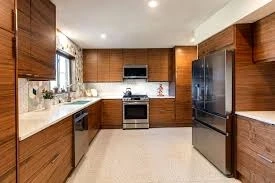Mid-century modern design, characterized by clean lines, functional forms, and a connection to nature, has made a significant resurgence in recent years. Among the various elements that define this aesthetic, mid-century modern kitchen cabinets stand out for their ability to blend simplicity with sophistication. This article explores the key features of mid-century modern kitchen cabinets, their historical context, and tips on how to incorporate them into contemporary homes.
Historical Context
Mid-century modern design emerged in the mid-20th century, roughly from the 1940s to the 1960s. Influenced by the Bauhaus movement and Scandinavian design principles, this style emphasized simplicity, minimalism, and functionality. Architects and designers like Frank Lloyd Wright, Charles and Ray Eames, and George Nelson were pivotal in popularizing this aesthetic.
In the context of kitchen design, mid-century modern kitchen cabinets became iconic for their sleek, uncluttered look. They often featured flat surfaces, simple hardware, and a focus on natural materials, reflecting the era's emphasis on practicality and beauty.
Key Features of Mid-Century Modern Kitchen Cabinets
Clean Lines and Minimalism Mid-century modern cabinets are known for their straight, clean lines and lack of ornate detailing. This simplicity creates a streamlined look that is both timeless and contemporary.Natural Materials Wood is a predominant material in mid-century modern cabinets, with walnut, teak, and oak being popular choices. The natural grain of the wood is often highlighted, adding warmth and texture to the kitchen space.Flat-Panel Doors Unlike traditional cabinets with raised or recessed panels, mid-century modern cabinets typically feature flat-panel doors. This design choice enhances the sleek, modern aesthetic.Integrated or Minimalist Hardware Cabinet hardware in mid-century modern design is either integrated into the doors or kept very minimal. Handles and pulls are usually simple, often made of metal, and sometimes feature a geometric or sculptural form.Functional Design Functionality is a core principle of mid-century modern design. Cabinets are designed to maximize storage and efficiency, often incorporating innovative solutions like pull-out shelves, lazy Susans, and deep drawers.Bold Colors and Finishes While natural wood tones are prevalent, mid-century modern cabinets also embrace bold colors and high-gloss finishes. Bright shades like mustard yellow, olive green, and turquoise can add a vibrant touch to the kitchen.Incorporating Mid-Century Modern Cabinets into Contemporary Kitchens
Blend with Modern Elements Combining mid-century modern cabinets with contemporary elements can create a harmonious and stylish kitchen. Pairing sleek cabinets with modern appliances, quartz countertops, and minimalist lighting fixtures can enhance the overall aesthetic.Use of Natural Light Mid-century modern design often emphasizes the connection to nature, so incorporating large windows or skylights can complement the natural materials used in the cabinets. Ample natural light will highlight the wood's grain and make the space feel more open and inviting.Mix and Match Materials To add depth and interest to your kitchen, consider mixing materials. Pair wooden mid-century modern cabinets with countertops made of concrete, stainless steel, or marble. This combination of textures can create a dynamic and visually appealing space.Incorporate Vintage Accessories To further embrace the mid-century modern vibe, incorporate vintage or retro accessories into your kitchen decor. Items like vintage bar stools, pendant lights, and colorful dishware can enhance the nostalgic feel of the space.Keep it Clutter-Free Mid-century modern design thrives on simplicity and minimalism. To maintain the integrity of this style, keep countertops and open shelving free of clutter. Opt for built-in storage solutions to keep kitchen essentials out of sight.Conclusion
Mid-century modern kitchen cabinets offer a timeless appeal that seamlessly blends form and function. Their clean lines, natural materials, and minimalist design make them a versatile choice for contemporary kitchens. Whether you’re renovating a historic home or updating a modern space, incorporating mid-century modern cabinets can bring a touch of elegance and sophistication to your kitchen. By blending these classic elements with modern touches, you can create a kitchen that is both stylish and practical, embodying the enduring charm of mid-century modern design.


